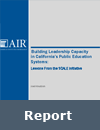The California Collaborative is an example of a growing trend toward cross-district networking and collaboration. District leaders increasingly recognize the value of working with their peers in other districts to tackle their most pressing challenges. Rather than operate in silos, districts can adapt promising ideas from other K-12 systems to meet their own local needs. They can identify and avoid the pitfalls that have slowed progress in other districts. They can even develop shared products that enrich their learning and accelerate their growth in the service of improved student outcomes.
This page provides a range of examples of cross-district collaborations and highlights the knowledge base emerging from districts’ experiences working across system lines. It includes:
- Rationale for Cross-District Collaboration
- Contributions from the Research Community
- Examples of Cross-District Collaboration
Rationale for Cross-District Collaboration
Contributions from the Research Community
Other Examples of Cross-District Collaboration
| Aspen Urban Superintendents Network | A strand of the Aspen Institute’s Education Program, this ongoing professional development seminar and peer-learning forum offers a platform for superintendents of urban school districts across the country to network and address major challenges confronting their districts. |
| CORE Districts | This network of nine California school districts aims to foster collaboration and learning to innovate, implement, and scale successful strategies and tools to better prepare students for college and career. |
| LCFF Collaborative Working Group | The California School Board Association and California Forward have brought together a network of district administrators and school board members to meet quarterly and reflect on the California’s Local Control Accountability Plans to identify both promising practices and systemic challenges in implementation of the Local Control Funding Formula (LCFF). |
| Math in Common | This group of ten districts work together, within and across districts, to advance student success in mathematics while implementing the Common Core State Standards in grades K-8. |
| SCALE Up | This collaborative partnership teams six small districts in California’s Central Valley to work together to improve district capacity through cross-district leadership development and training. |
| Stanford English Language Learner Leadership Network | This collaboration between researchers at Stanford University and district level practitioners supports seven small to middle sized districts in Central and Northern California in improving academic outcomes for English learners. |
| Urban Education Dialogue | This network brings together superintendents from California urban schools for a two-day meeting to share best practices, generate creative ideas about current education issues, and improve education policy. |
We welcome any suggestions for additional examples that merit attention here. Please contact us at cacollaborative@air.org.





